Rail accidents: India
This is a collection of articles archived for the excellence of their content. |
Causes
1995- 2020
June 9, 2023: The Times of India
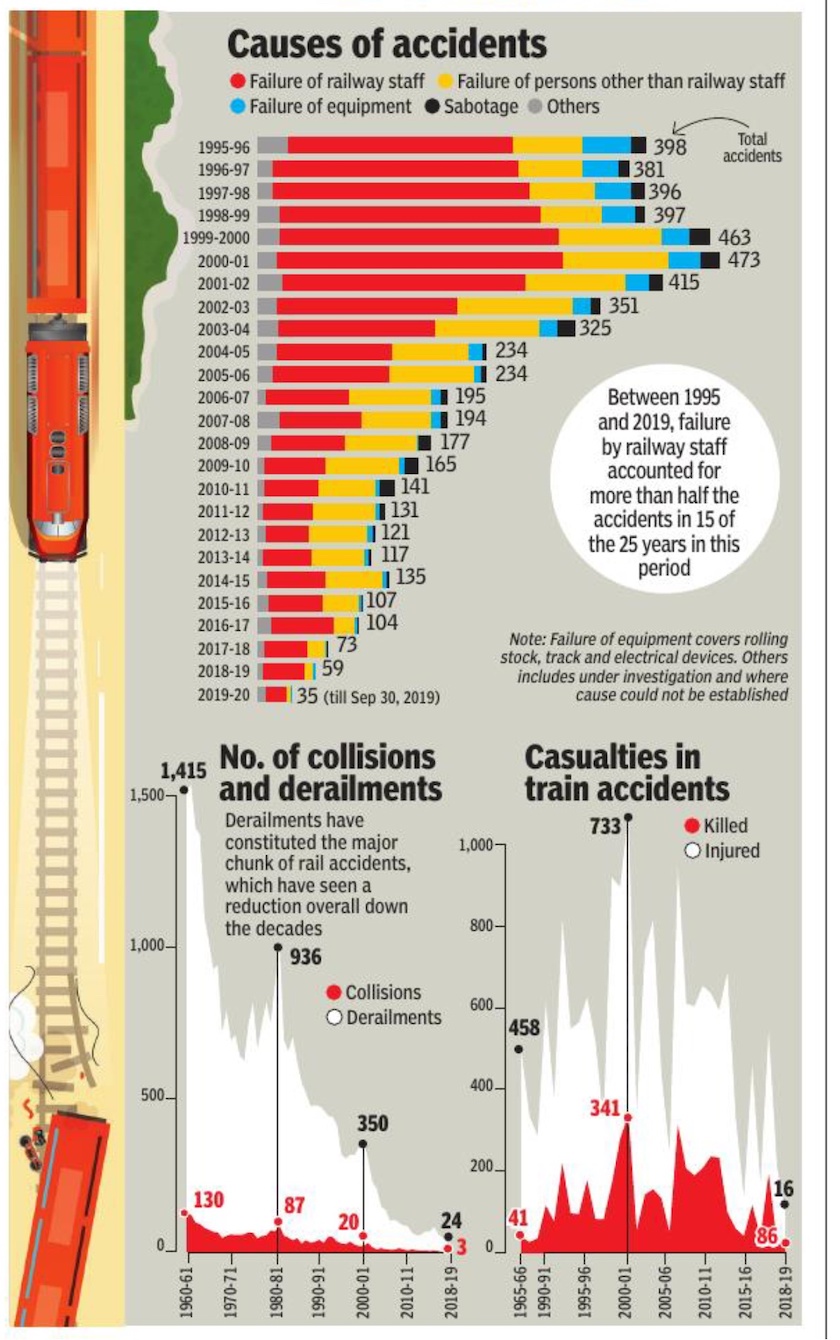
From: June 9, 2023: The Times of India
Accident-Prone Despite Safeguards
Government documents underline a raft of measures to “eliminate human failure” in the running of trains. These include an electronic interlocking system (a safety mechanism that prevents conflicting train movements on tracks by controlling the signals and points or switches in a coordinated manner). Electronic interlocking is completely computer-based and without any human element.
Further, a signalling system based on European technology has been adopted to “avoid train accidents/collisions on account of human error” or speeding.
Safety measures have also been taken on the passenger side, like in the rollout of “superior and safer” Linke Hofmann Busch (LHB) coaches. Experts said LHB coaches prevented a higher toll in the Balasore mishap.
Despite these, human error has been behind the majority of consequential train accidents in recent years. Consequential train accidents are those that have serious repercussions, including loss of human life, injury, loss of railway property and interruption to rail traffic.
Examples of human errors include overspeeding, passing signals at danger, carrying out maintenance without getting proper block of stretches, poor maintenance of equipment, etc.
Signal At Every Kilometre: CAG
A 2022 report by the CAG on ‘Derailment in Indian Railways’ refers to the Parliamentary Standing Committee on Railways, which noted that there has been a “substantial increase” in the number of signals and “loco-pilot encounters a signal almost every kilometre of his run and almost every minute he has to see a signal and accordingly control the train”. But “there is no technological support available to the loco-pilots and they have to depend on vigilant watch of the signal for controlling the train”. It said the rail ministry has “failed to assess the root cause of continuous and possible repeated lapses by railway staff and therefore failed completely to curb such accidents”. The railways’ safety directorate says that even under “optimum field conditions and with the best of intentions, a human being is likely to commit a mistake from time to time”. Thus, multiple redundancies are built into processes and steps have been taken to ensure that equipment is used to prevent human error. However, it notes that “another reason for high incidence of human failures is that technical safeguards and backups do not necessarily replace human effort”. Staff becomes complacent with the knowledge that technical support is available for flagging their mistakes, it says.
How Europe, Japan Approach Rail Safety
Indian Railways has started deploying Kavach, an indigenously developed anti-collision system that automatically applies brakes on trains when an obstruction is detected ahead on the same track. Kavach helps train operators avoid overspeeding and passing signals at dangerous speeds. If two trains are approaching each other on the same track, SOS signals are sent to both trains and Kavach automatically stops the trains at least 300 metres from each other. But the system is only active along 2% of India’s rail network.
Earlier this year, railway minister Ashwini Vaishnaw said Kavach is on a par with the European Train Control System (ETCS), which is used across the world, including in China, South Korea and Australia.
Since their introduction about 50 years ago, Japan’s bullet trains have carried 10 billion passengers and seen no casualties from derailments or collisions. They use the Automatic Train Control system, which eliminates trackside signals in favour of centralised and automated traffic control. Trains, which routinely travel at over 350kmph, are also equipped with sensors that can detect obstructions or impending collisions and automatically apply the brakes to stop a train moving at top speed within 300 metres. Japanese trains and tracks also use devices that prevent trains from colliding with walls or tipping over in the event of an earthquake.
Source: Lok Sabha Secretariat Indian Railways Safety Performance Fact Sheet (2019), Indian Railways, CAG Derailment in Indian Railways report 2022
2018: Jaywalking, encroachments, shorter route
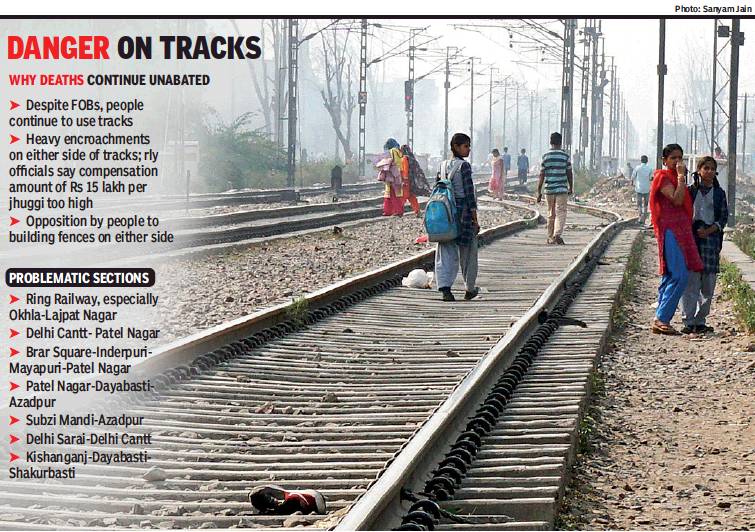
From: Jasjeev Gandhiok, Why 100 people die on rly tracks in city every year, October 30, 2018: The Times of India
JAYWALKING: Encroachments, Shorter Route To Blame
The capital hasn’t learn any lessons from the Amritsar train tragedy, it seems. Three men were crushed by a train while they were sitting on the tracks and drinking on Monday mor ning.
When TOI visited the spot just hours after the incident, people, including schoolchildren, were seen crossing the same tracks. On an average, nearly 100 people die in Delhi on railway tracks every year. Aren’t these people worried about their safety? They said they had no other option as it’s the shortest way to the other side.
On either end of the tracks are settlements, and railway officials say it becomes extremely difficult to clamp down on jaywalking on the tracks when there are encroachments.
“We identified a number of key stretches where such incidents are taking place, and while RPF personnel have been increased in some areas, people seldom listen and continue to use the tracks despite FOBs present at some locations,” said R N Singh, DRM, Delhi division.
Railway officials also say the process ofremoving jhuggis was further hampered in 2016 when the state government raised the compensation amount ofremoving a jhuggi from Rs 15,000 to Rs 15 lakh per jhuggi.
“Wherever JJ clusters have come within 15 metres of the tracks, they adversely affect track maintenance and operations. Safety also becomes a concern and we have tried making people more aware of the dangers of crossing tracks in such a manner,” said a senior railway official.
But locals complain that very little has been done to cater to their safety, with the tracks becoming gambling dens where snatchers are also on the prowl.
“People drink there at night and women can’t go near the area either. People have no option but to use the tracks to cross to the other side, as the crossing to the other colony is 2km away. People would rather risk it and use the tracks instead,” said Santosh, a 60-year-old resident of Prem Nagar, one of the colonies.
Residents of Veena Enclave at the other end of the tracks have a similar tale to tell. Kamla Devi, a housewife, said the area has seen numerous deaths in the past but RPF personnel seldom patrol the area. “No one is present to deter people from going on to the tracks and there is no security at night. People feel unsafe as a lot of crime also happens at night when those returning from work are crossing the tracks,” said Devi.
Railway officials said they are trying to secure critical points by adding fences. “People have opposed fencing as they want to continue using the tracks. But penal action and more FOBs should change things,” Singh said.
Rail signal failure
2017 – 22
Dipak Dash, July 22, 2023: The Times of India
New Delhi : There have been 13 instances of signalling failure in the railways in the past five years but no incident due to defects in the interlocking signal system, railway minister Ashwini Vaishnaw told Rajya Sabha. He said there was no loss of life in any of these instances.
Answering over two dozen questions in the wake of Balasore train tragedy, the minister, quoting the probe by Commissioner of Railway Safety (CRS), said lapses in the ‘signalling-circuit-alteration’ resulting in wrong signal caused the triple train crash last month. The minister also said there has been “no incident due to defects in the interlocking signal system” in the past five years.
In a written reply, the minister said, “No expert has pointed out any loopholes or deficiencies in the (interlock ing signal) system.” Railway ministry officials have claimed that human interference in the system caused the accident, which claimed 295 lives and left 176 grievously injured. While CRS has investigated the technical side of the accident, CBI is probing criminality.
MPs from different parties asked over two dozen questions relating to safety issues in railways, including the Balasore accident, derailments, signal failure and installation of ‘Kavach’ anticollision system in trains.
Referring to the CRS report, the minister said, “The rear-collision was due to the lapses in the signallingcircuit-alteration carried out at the North Signal Goomty (of the Bahanaga station) in the past, and during the execution of the signalling work related to replacement of Electric Lifting Barrier for level crossing gate no 94 at the station.”
As per the report, these errors resulted in a green signal being displayed for the wrong line, leading to the illfated Coromandel Express colliding with a stationary goods train. The railways has suspended seven railway officials and has initiated disciplinary proceedings against them. The minister said so far bodies of 254 victims have been handed over to their kin while 41 bodies are yet to be identified. The railways has paid Rs 29.5 crore as enhanced ex gratia.
State-wise
AP: 2018-23
June 5, 2023: The Times of India
VISAKHAPATNAM: A little more than 5,780 people have lost their lives in train-related accidents in Andhra Pradesh in the past five years. However, a vast majority of the deaths related to passengers falling off running trains or people getting run over. Suicides on railway tracks also make a formidable number.
According to the National Crime Records Bureau (NCRB), 760 people died in 755 railway accidents in Andhra Pradesh in 2021. In 2020, 613 people were killed in 611 railway accidents, and 1,519 people were killed in 1,511 railway accidents in 2019. Similarly, 1,525 railway accidents resulted in the death of 1,531 people in 2018 while 1,362 railway accidents claimed 1,365 lives in 2017. In most cases the deaths were due to negligence of passengers travelling in trains or people crossing the tracks. The NCRB has classified railway accident deaths into five categories - derailment, collision, explosions/fires, people falling from trains or trains colliding with people on tracks and other cause.
However, there were only a few major railway accidents in Andhra Pradesh in the past five years.
Andhra Pradesh reported a major train accident in January 2017. 41 died in Hirakhand train tragedy in 2017.
The derailment of (Jagdalpur-Jungarh RoadBhubaneswar) Hirakhand express train claimed 41 lives near Kuneru village in Komarada mandal in Vizianagaram district in January 2017.
A ‘sabotage’ theory was floated by some, but the forensic report ruled out traces of explosives. A total of 32 people, including six women and three children, were burnt to death when flames engulfed the sleeper coach of Chennai-bound Tamil Nadu express train near Nellore in AP in July 2012.
In November 3, 2013, a speeding passenger train ran over passengers of Bokaro Express waiting on an adjacent track after rumours spread that S-1 coach of (Alappuzha-Dhanbadh) Bokaro express they were in caught fire, leaving nine persons dead at Gotlam locality in Vizianagaram district.
There were several incidents of people being killed after they were hit by speeding trains while they were crossing the tracks in various parts of the state. Crossing the rail track is an offence but people continue to cross the tracks without checking the movement of trains, said a senior officer with the railway police
Year-wise statistics
See graphics on this page, including 'Train accidents with the highest number of casualties, 1988- Nov 2016'

ii) The highest number of casualties was in 1981;
iii) The number of people who travel by trains in India every day.
The Times of India
See graphics on this page, including 'Train accidents with the highest number of casualties,2006- Nov 2016'
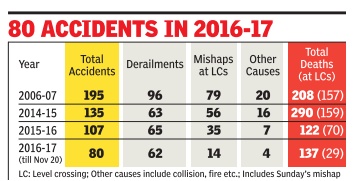
The Times of India
See graphics on this page, including ‘Rail accidents in India: 2009-March 2015’ and Train accidents with the highest number of casualties, 1995- Nov 2016

The Times of India and The Indian Express
40% of rail mishaps are at level crossings
The Times of India, Aug 25 2015
40% of rail mishaps are at level crossings
Mahendra Singh
Mishaps at level crossings are the biggest killers, accounting for 40% of train accidents and 66% of fatalities, reflecting the cashstrapped railways' failure to eliminate these crossings by building road-over bridges and road-under-bridges.
The latest data shows that there are 29,487 level crossings, of which around 10,440 are unmanned. Between 2008 and 2015, only 1,344 manned and 7,650 unmanned crossings have been eliminated. In 2015-16, railways targets to get rid of 820 unmanned and 205 manned crossings.
Around 18 accidents on unmanned crossing and three on manned have been reported since April 2015.
1961- 2019
See graphic:
Train accidents per mn km travelled, 1961- 2019
Ex-gratia payment for accidents not revised, 1997-2016
IANS, Damages for train accident victims unchanged for 19 yrs', 21 Nov 2016
Even though the cost of living and medical treatment have shot up manifold in the last two decades, the ex-gratia amount given to the kin of those killed in rail accidents has remained unchanged for the last 19 years.
The Rs 4-lakh ex-gratia was fixed way back in 1997, and it continues to be the norm even in 2016. This is in sharp contrast to the previous practice of upward revision of the amount every 10 years or so. For the first time in Independent India, Rs 10,000 ex-gratia was fixed for the families of the dead in a 1962 train disaster, which was doubled in 1963.
[Indpaedia points out that railway fares have not been revised much since 1997 either. Secondly, travel insurance is available for less than Re.1.]
2003-2013
Chronology of major train disasters in last 10 years
PTI | Dec 28, 2013
An air-conditioned coach of the Bangalore-Nanded Express train caught fire in the early hours of Saturday in Anantpur district of Andhra Pradesh, killing 26 people and injuring 13 others.
Following is the chronology of major train disasters in the last 10 years:
May 15, 2003: A burst stove in the Mumbai-Amritsar Golden Temple Express (Frontier Mail) near Ludhiana in Punjab led to a major fire, killing 40 people and injured more than 50.
June 22, 2003: 53 people were killed and 25 others injured in an accident on the Konkan Railway when the engine and three coaches of the Karwar-Mumbai Central Holiday Special train derailed after crossing Vaibhavwadi station in Maharashtra.
July 2, 2003: At least 22 passengers and motorists were killed in a bizarre but ghastly accident in Andhra Pradesh when the engine and two coaches of a train fell off a bridge crushing vehicles passing underneath.
June 16, 2004: Matsyagandha Express skidded off the tracks while crossing a bridge in Maharashtra's Raigarh district, killing 20 people and injuring over 60.
Dec 1, 2006: A portion of a 150-year-old bridge collapsed over a passing train in Bihar's Bhagalpur district, killing 35 and injuring 17.
Dec 14, 2007: Ludhiana-Ferozpur Express rammed a min bus near Ajitwal station killing 16 people.
Aug 1, 2008: A Secunderabad-Kakinada nightly Gautami Express with 360 passengers catches fire near Tadallapusalapalli station in Warangal killing at least 31 passengers.
Jan 25, 2009: Kanpur-Allahabad train rammed a truck near Unchahar station killing 12 people.
Feb 22, 2009: A local passenger-train hit a Bolero in an unmanned level crossing near Barapalli station killing 15 people.
Apr 28, 2009: Tanakpur-Kasganj passenger train hit a bus at an unmanned level crossing near Ghatpuri station killing 11 people.
Oct 21, 2009: 23 persons were killed when Goa Express hit Mewad Express from behind near Mathura station killing 23.
Nov 1, 2009: Gorakhpur-Ayodhya passenger train hit a truck at unmanned level crossing near Tikri station, killing 18 people.
Jan 2, 2010: Prayagraj Express collided with Gorakhdham Express from its rear portion near Panki station killing 12.
May 28, 2010: At least 150 people were killed after Gyaneshwari Express was derailed by Naxals in West Midnapore district of West Bengal.
Jul 19, 2010: Uttar Banga Express hit Vananchal Express from behind at Sainthia station killing 66.
Oct 20, 2010: Indore-Gwalior Intercity express collided with a goods train at Badarbas station killing 24.
May 22, 2011: Garibrath Express rammed a Bolero at an unmanned level crossing near Madhubani station killing 20.
July 7, 2011: Mathura-Chapra Express rammed a bus at an unmanned crossing near Patiayali station killing 39.
July 10, 2011: Kalka mail derailed at Malwa station killing 71.
Nov 22, 2011: Seven people were burnt to death when the Howrah-Dehradun express caught fire in Giridih in Jharkhand.
Jan 11, 2012: Five persons were killed and nine others, including a child, injured in a collision between the Delhi-bound Brahmaputra Mail and a stationary goods train.
Mar 20, 2012: Mathura-Kasganj passenger rammed a min bus at an unmanned level crossing near Hathras station killing 15.
May, 22 2012: Twenty-five people were killed when the Banglore-bound Hampi Express collided with a stationary goods train in Andhra Pradesh's Anantapur district.
May 31, 2012: Howrah-Dehradun Doon Express derailed near Jaunpur killing 7 people.
Jun 30, 2012: Thirty-five passengers were killed and 25 others injured when a coach of the Delhi-Chennai Tamil Nadu Express caught fire near Nellore in Andhra Pradesh.
Apr 10, 2013: Seven compartments of the 15228 Muzaffarpur-Yesvantpur Weekly Express derailed near Arakkonam, 40km from Chennai killing one passenger and leaving another seriously injured.
Aug 19, 2013: At least 35 people died when Rajya Rani Express ran over people at the Dhamara station near Saharsa in Bihar.
Nov 2, 2013: The Raigarh-Vijaywada train ran over 8 people at Gotlam railway station in Vizianagaram district in Andhra Pradesh.
2007-17, number of accidents
The Times of India, Aug 23, 2017
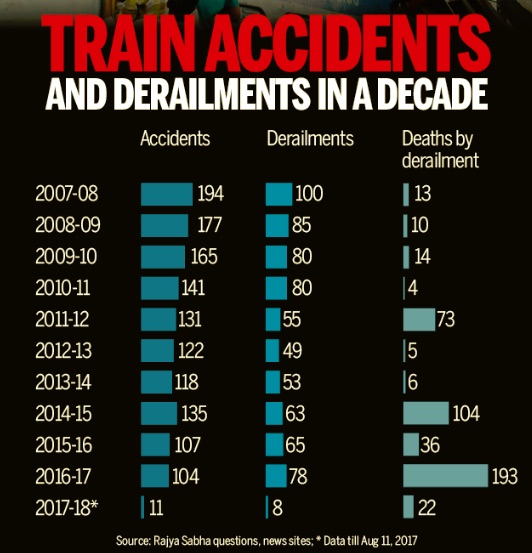
See graphic: Train accidents and derailments, 2007-2017
Fatalities from train derailments in 2016-17 were the highest in the last decade at 193. This despite a drop in train accidents in the last two years. However, the two accidents in August 2017—the derailment of the Utkal Express on August 19 and the Kaifiyat Express on August 23, have once again raised questions about the Railways commitment to passenger safety and the delayed implementation of safety norms.
2009-15
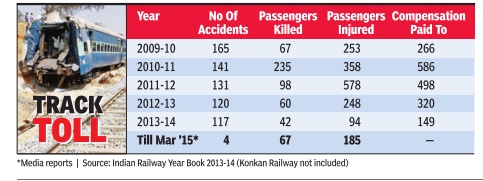
See graphic:
Rail accidents in India: 2009-March 2015
2012-17: derailments and fatalities
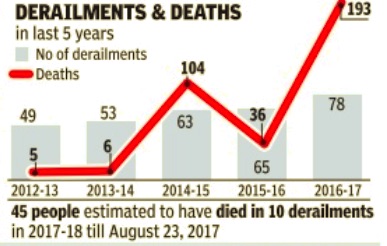
From The Times of India, August 24, 2017
See graphic, Derailments and deaths, 2012-17
2012-17: Deaths at unmanned level crossings dip 66%
`Deaths at unmanned level crossings dip by 66% in 5 yrs’, August 14, 2017: The Times of India

A parliamentary panel has found that the number of train accidents as well as casualties at unmanned level crossings has come down in the last five years.
Railways Convention Committee, in its report submitted in Parliament, noted that the number of accidents in 2012-'13 was 53, which came down to 20 in 2016-'17. The committee, headed by BJD MP Bhartruhari Mahtab, found that the number of casualties due to accidents at unmanned crossings has come down from 123 in 2012-'13 to 40 in 2016-’17.
The panel found that as many as 6,169 unmanned level crossings have been eliminated in the last five years, the highest (1,503) being in 2016-'17. “What is more encouraging is the fact that three zonal railways -Central, Eastern and West Central -have been able to completely eliminate unmanned level crossings,“ it said.
As of April 2017, there were 27,054 level crossings on the railways network: 19,504 manned and 7,550 unmanned.
The Railway Board chairman informed the committee that as of April 2017, the total number of unmanned crossings (in broad gauge) were 4,943 and it intended to remove them in three years. Railways has set the target of elimination of 1,500 unmanned crossings in 2017-'18, 1,500 in 2018-'19 and 1,943 in 2019-’20.
The committee has also suggested that the railways pay compensation to road us ers who are killed or injured at level crossings, without making them go through the judicial process. It recommended that the cause of each accident at level crossings should be investigated, preferably by an outside agency .
“...and if lapses on the part of the railways are established based on such investigations, Indian Railways should suo motu pay compensation to the road users also, instead of waiting for a decree by the MACT (Motor Accident Claims Tribunal) or any other court so as to avoid time consuming process of litigation,“ it said.
As of now, under the Railways Act, 1989, liability of the railways to provide compensation is limited to rail passengers who are victims of accidents. Road users are given compensation only if decreed by MACT or another court.
2014-17
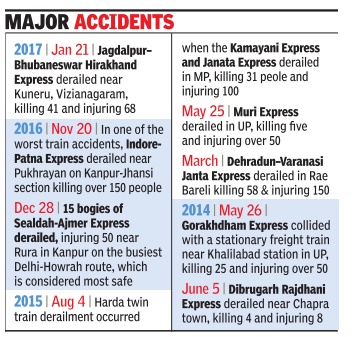
See graphic:
Major railway accidents, 2014-17
2016-17: most accidents since 2011

The principal causes of railway accidents in India
From: May 24, 2018: The Times of India
See graphic:
Passengers killed in accidents, 2001-2017.
The principal causes of railway accidents in India
2017-18: Railways' best safety record in 5 years
With 40 deaths in 75 accidents between September 2017 and August 2018, the Railways has registered its best safety figures in five years for the corresponding 12-month period, a ministry official has said, quoting official data.
There were 80 train accidents and 249 fatalities between September 2016 and August 2017 -- the Indore-Patna Express derailment near Kanpur in November 2016 alone had killed over 150 passengers. In the corresponding period for 2017 and 2018, the number of deaths stood at 40, the official said.
There were two major accidents during this period -- the derailment of the Utkal Express in August 2017 which killed over 20 people, and the the death of 13 children in Uttar Pradesh on April 26 this year after a train rammed into their school van.
Similarly, between September 2013 and August 2014, the number of deaths was 275 in 139 accidents, in the corresponding period in 2014-2015, the number was 196 deaths in 108 accidents.
"Comparing the figures of the period between September 1, 2013 to August 31, 2014 to that of the number between September 1, 2017 to August 31, 2018, the fatality figures in collisions and derailments (whose causes the railways can address, according to the official) taken together have come down from 62 to 4- a 93 per cent reduction," he said.
"Whereas injury figures in collision and derailment came down from 272 to 12 (95.6 per cent reduction). The total number of collision and derailments have come down from 69 to 56 during this period," the senior official said.
The rest 36 deaths in 2017-2018 were accounted for by other factors such as mishaps at unmanned-level crossings (28 fatalities), six deaths at manned-level crossings, one in a coach fire accidents and one in "miscellaneous" accidents, according to the official data.
"Better tracks, replacement of existing coaches with LHB ones and more focus on maintenance in the last four years have resulted in fewer accidents due to technical reasons," he said.
The official further said that the vast reduction in injuries and fatalities happened primarily because of the massive renewal of tracks, regular safety reviews, better safety training of staff and close monitoring of safety performance undertaken during the period.
Another aspect which has contributed to better safety figures is removal of unmanned level-crossings — the railways plans to eliminate them completely by March 2020.
The national transporter has been aggressively removing UMLCs — 1,565 of them were eliminated in 2017-18 which resulted in fewer accidents. The target is of removing 1,600 such UMLCs in 2018-19, the official said.
The number of accidents at unmanned level crossings owing to the negligence of road vehicle users during September 2013 to August 2014 was 52, in the corresponding period in 2014-15 the number stood at 39, in 2015-2016 it was 23, in 2016-17 it was 13 and it reduced to just eight in the corresponding period of 2017-18, according to the data.
Sabotage cases, February 2017
See graphic:
Suspected cases of rail sabotage, February 2017
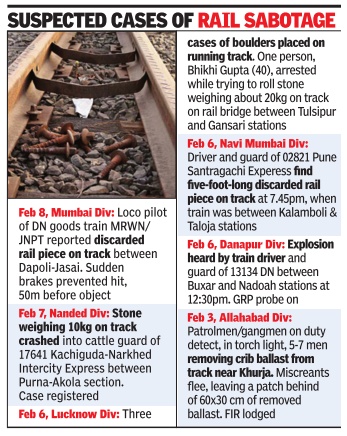
The Times of India, August 23, 2017
`Unofficial' track repair work
The Utkal Express mishap, which claimed 23 lives, has brought into focus smaller incidents that keep happening due to “unofficial“ maintenance of tracks where repair work is undertaken without taking permission from authorities and not following prescribed norms.
In this “short-cut“ method, officials do not put any speed restriction, such as red flag or signal warning, on the route and try to complete the maintenance work when there is no train operation.
Several officials of engineering department admitted that on many occasions they resorted to the practice of “unofficially“ doing repair works as seeking “block“ (time period) might delay some trains running on the route, which in turn gets reflected in performance report of the concerned officer and of the division and zone. “Due to heavy traffic, it is also very difficult to take blocks for maintenance. We are also under tre mendous pressure to do repair work on time,“ an official told TOI. There is a provision that in an emergency situation maintenance work can be done by putting up red flags on both the sides at 1200 metres.
As reported by TOI, the engineering department of Delhi division was doing repair work “unofficially“ at Khatauli and railways has admitted maintenance work was on without proper norms.Mohammed Jamshed, member (traffic), railway board said it was not “clear“ what kind of work was going on at the site. “We have maintenance ma nuals which lay down guidelines for work on any kind of railway infrastructure.“
As per reports, officials were aware 14-15m of track at the accident site needed urgent repairs, but they resorted to “short-cut“ since the stretch saw heavy traffic and feared causing delays would reflect poorly on records.
Another issue is recruitment of overqualified track maintenance staff. “MBAs, BE engineers are joining as trackmen who are not ready to listen to supervisor. Most are preparing for other competitive exams so try to get posted at the bungalows of senior officials,“ said a source.
With railways struggling to check increase in deaths due to 50% spike in cases of derailments of trains, Niti Aayog has found that while human failure accounted for 87% of mishaps, there has been a 60% increase in number of accidents for which engineering directorate was responsible.
Accidents due to failure of railways staff stood at 64 (2016-17) against 55 (2015-16), 60 (2014-15). Failure of staff accounted for 61.5% of the total accidents in 2016-17.
Those dying getting on, off train, must be paid by the Railways: SC/ 2018
Transporter To Compensate For Injuries Too: SC
The Supreme Court ruled that the railways would be liable to pay compensation to passengers in case of death or injury while boarding and de-boarding trains and said it cannot deny such claims citing negligence on the part of passengers.
A bench of Justices A K Goel and R F Nariman held that death or injury during boarding or de-boarding a train will be an ‘untoward incident’ entitling the victim to compensation.
As per Section 124A of the Railways Act, 1989, no compensation shall be payable by the railway administration if the passenger dies or suffers injury due to suicide or attempted suicide by him, self-inflicted injury, his own criminal act or any act committed by him in a state of intoxication or insanity.
Different high courts have given contradictory verdicts as some of them held that injury or death during boarding and deboarding because of negligence of the victim was at par with self-inflicted injury. Some HCs though applied the principles of strict liability on the railways for such incidents.
Putting an end to the controversy, the apex court ruled that the railways is liable to pay compensation to victims as compensation is payable whether or not there has been wrongful act, neglect or fault on the part of the railway administration in case of an accident or untoward incident.
The court said the concept of ‘self-inflicted injury’ would require intention to inflict such injury and negligence on the part of passenger, which is one of the grounds to decline compensation, could not be brought within its ambit.
